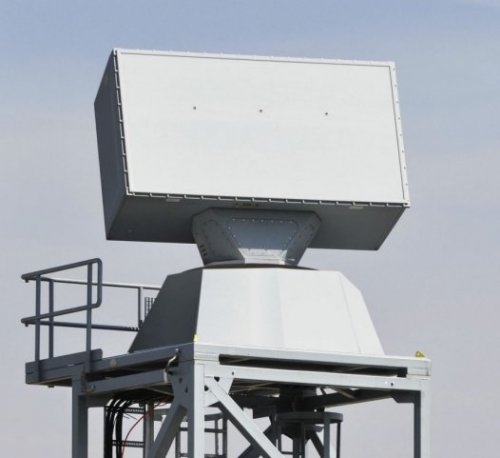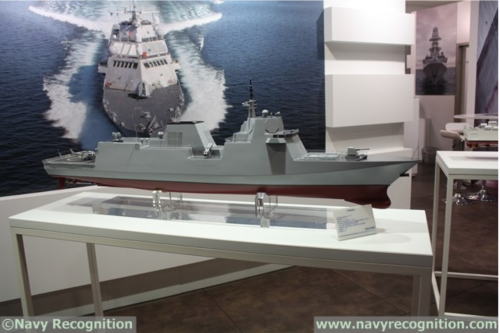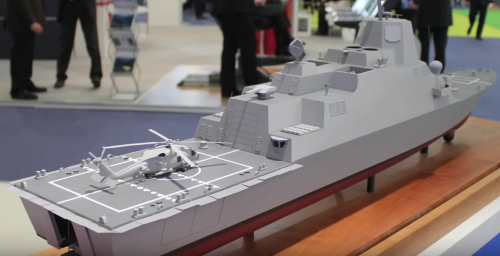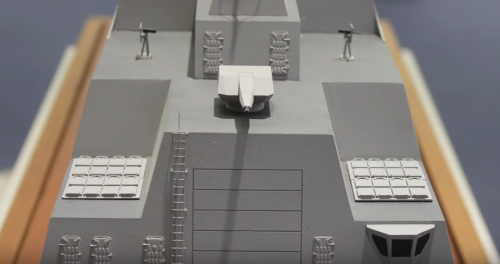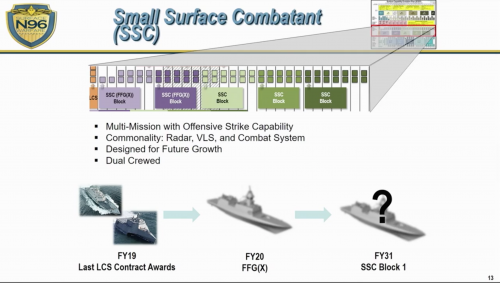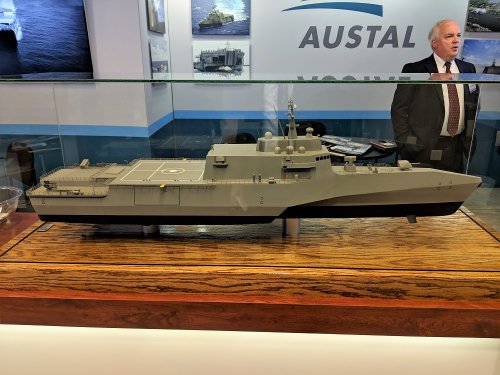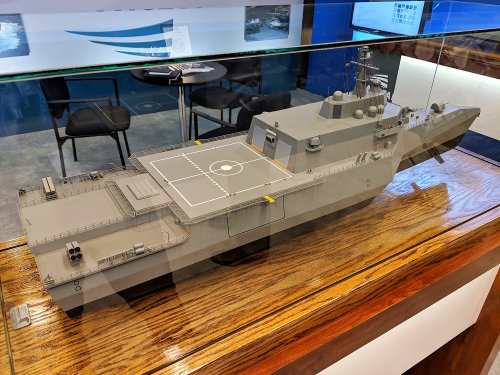If you look at the 36 second mark you will see a series of splashes in the water. I don't know if those are tied to the "blobs" that come off the round but then it leaves open to question what else could have caused the splashes.
You are using an out of date browser. It may not display this or other websites correctly.
You should upgrade or use an alternative browser.
You should upgrade or use an alternative browser.
Littoral Combat Ship - Freedom/Independence
- Thread starter Triton
- Start date
- Joined
- 16 April 2008
- Messages
- 9,602
- Reaction score
- 14,482
Yeah, at 1:01, there is also a line of stuff smaller headed downward from the projectile. Interestingly, the contract announcement (upthread) talks about the round firing "four energetic bolts" for divert, but there are clearly more than four large objects (I count six) coming out in the video.
So probably it's a solid object being fired out to divert, but maybe it's evolved since the original 4-bolt design.
So probably it's a solid object being fired out to divert, but maybe it's evolved since the original 4-bolt design.
bring_it_on
I really should change my personal text
- Joined
- 4 July 2013
- Messages
- 3,661
- Reaction score
- 3,797
- Joined
- 3 June 2011
- Messages
- 18,332
- Reaction score
- 12,214
That video a couple years back, with three Hellfires on three boats, was more impressive. I'm wondering why they're still (pardon the expression) dicking around with this instead of having them already out there in the fleet.
Last edited:
- Joined
- 21 April 2009
- Messages
- 13,746
- Reaction score
- 7,667
sferrin said:That video a couple years back, with three Hellfires on three boats, was more impressive. I'm wondering why they're still (pardon the expression) dicking around with this instead of having them already out there in the fleet.
Slightly of topic but why wouldn't the Army convert some of the thousands of M113s to Hellfire or Javelin vertical launch anti-tank platforms?
- Joined
- 4 July 2010
- Messages
- 2,514
- Reaction score
- 3,090
Congress to buy 3 more LCS than the Navy needs but gut funding for sensors that make them valuable.
Appropriators cut all funding in 2019 for the anti-submarine warfare package, a variable-depth sonar and multi-function towed array system that the Navy was aiming to have declared operational next year, citing only that the funding was “ahead of need." The National Defense Authorization Act had authorized about $7.4 million, still well below the $57.3 million requested by the Navy, citing delays in testing various components.
Appropriators are also poised to half the requested funding for the surface warfare package and cut nearly $25.25 million from the minesweeping package, which equates to about a 21 percent cut from the requested and authorized $124.1 million
The annual cutting spree has created a baffling cycle of inanity wherein Congress, unhappy with the development of the modules falling behind schedule, will cut funding and cause development to fall further behind schedule, according to a source familiar with the details of the impact of the cuts who spoke on background. All this while Congress continues to pump money into building ships without any of the mission packages having achieved what’s known as initial operating capability, meaning the equipment is ready to deploy in some capacity.
That means that with 15 of the currently funded 32 ships already delivered to the fleet, not one of them can deploy with the package of sensors for which the ship was built in the first place, a situation that doesn’t have a clear end state while the the programs are caught in a sucking vortex of cuts and delays.
The Airborne Laser Mine Detection System is part of the Mine Warfare package for the LCS. The RAMICS supercavitating gun was originally going to be used as a means to destroy mines after they had been mapped. This video from NAMMO may be related to development testing of the supercavitating rounds.
Old ALMDS and RAMICS video from Northrop
https://www.youtube.com/watch?v=k1gQuW5VBos
NAMMO supercavitating round test video. Video Description:
Old ALMDS and RAMICS video from Northrop
https://www.youtube.com/watch?v=k1gQuW5VBos
NAMMO supercavitating round test video. Video Description:
https://www.youtube.com/watch?v=QlAVXMaRl7wNammo’s 30 mm Swimmer (APFSDS-T MK 258 Mod 1) swims straight through water, thanks to a groundbreaking design on the supercavitating projectile developed in cooperation with the US Navy. This video is the first time we are able to show the performance of the ammunition in public. (Note: video has no audio)
bring_it_on
I really should change my personal text
- Joined
- 4 July 2013
- Messages
- 3,661
- Reaction score
- 3,797
Rate of fire is better appreciated in the video you had posted earlier of the 3 hellfire launch.
https://www.secretprojects.co.uk/forum/index.php/topic,6234.msg301798.html#msg301798
Has the Navy discussed which of the 4 LCS ships expected to be deployed this year will feature the Surface to surface Missile Module and the NSM and also whether the mid-late 2019 is still the target for first NSM and launcher installations?
https://www.secretprojects.co.uk/forum/index.php/topic,6234.msg301798.html#msg301798
Has the Navy discussed which of the 4 LCS ships expected to be deployed this year will feature the Surface to surface Missile Module and the NSM and also whether the mid-late 2019 is still the target for first NSM and launcher installations?
bring_it_on
I really should change my personal text
- Joined
- 4 July 2013
- Messages
- 3,661
- Reaction score
- 3,797
Was able to find some information from this article from the Diplomat from October, 2018:
US Navy’s New Naval Strike Missile to Deploy in 2019
https://www.youtube.com/watch?v=O9LmJctW-wI
US Navy’s New Naval Strike Missile to Deploy in 2019
“In that initial over-the-horizon award for LCS, the installation timeline was on a two-year delivery cycle,” Octavio Babuca of Raytheon company told Defense News. “But we are now working with the Navy to support an accelerated timeline to the deploying to littoral combat ships. That is mid-to-late 2019 time window.”
https://www.youtube.com/watch?v=O9LmJctW-wI
Hellfire tests are supposed to wrap up early this year with a likely decision on making it part of the standard surface warfare package. The NSM missile will probably be added as well but no idea when. The 57mm guided projectile will also probably be put into production.
Unless the Army resurrects the PAM missile, I don't see the Navy spending its own money to create a compact VLS missile with 20 mile range. JAGM is still progressing so it can be expected to eventually replace the Hellfire.
Unless the Army resurrects the PAM missile, I don't see the Navy spending its own money to create a compact VLS missile with 20 mile range. JAGM is still progressing so it can be expected to eventually replace the Hellfire.
bring_it_on
I really should change my personal text
- Joined
- 4 July 2013
- Messages
- 3,661
- Reaction score
- 3,797
From what I have been able to gather, most of the ships that deploy in 2019 would do so with the SUW module and I assume this will include both the guns and the hellfire. The aim is still to start installing the NSM on the ships by "mid-late 2019" and I think Raytheon and Kongsberg are working to get this out as soon as possible. It is quite likely that at least some of the ships that deploy in 2019 will carry the NSM. LCS-17 will be commissioned this year and IIRC will be the first ship with the TRS-4D GaN AESA radar. Alamo could come as early as 2020 and I think 2020/2021 is also when they deploy the MQ-8C.
Joe DePietro, Lockheed Martin’s vice president for small combatants and ship systems, said his company was working toward integrating the Naval Strike Missile into LCS-7, the Detroit.
"We are working right now to put the Naval Strike Missile on LCS-7, he said, “in support of an upcoming deployment. That’s going to be a fleet decision but we are doing all the design work now to put the missile on the ship.”
https://www.defensenews.com/digital-show-dailies/euronaval/2018/10/24/the-us-navys-new-ship-killer-missile-slated-to-make-its-fleet-debut-much-sooner-than-expected/
Interesting. Have any details about that?bring_it_on said:LCS-17 will be commissioned this year and IIRC will be the first ship with the TRS-4D GaN AESA radar
bring_it_on
I really should change my personal text
- Joined
- 4 July 2013
- Messages
- 3,661
- Reaction score
- 3,797
GARGEAN said:Interesting. Have any details about that?bring_it_on said:LCS-17 will be commissioned this year and IIRC will be the first ship with the TRS-4D GaN AESA radar
I was wrong on that commissioning for LCS-17. It will occur next year not this year. LCS-17 is the first ship of the Freedom class that is moving from the TRS-3D radar, which is standard on all Freedom class ships, to TRS-4D which is a C band GaN AESA radar and is a single face rotating version of the fixed panel TRS-4D that Hensoldt has on offer for frigates and other ships. The Saudi MMSC variant of the Freedom LCS will also feature the -4D. The USN and Lockheed were on site in Germany to witness its Factory Acceptance Testing back in late 2015.
Here's some background on it from Jane's from a couple of years ago -
Based on solid-state Gallium Nitride technology, TRS-4D is a software-driven radar employing full digital beamforming, and with pulse-Doppler processing in all beams. The rotator variant features a single-face AESA antenna rotating at either 15 rpm or 30 rpm (depending on the update rate required) at 2-70° in elevation. The use of an AESA array, with instantaneous dual-axis beamsteering in both azimuth and elevation, allows for 'backward scanning' to ensure fast-track initiation.
According to Airbus, the radar's AESA technology "delivers increased sensitivity to detect smaller targets with greater accuracy, as well as faster track generation to give LCS more time to react to advanced threats". Alternatively, the antenna can be kept stationary if fixed on a defined segment of space (scanning a sector of up to 50° in azimuth).
Attachments
bring_it_on
I really should change my personal text
- Joined
- 4 July 2013
- Messages
- 3,661
- Reaction score
- 3,797
I haven't looked at this recently but I think there may be GaN versions of the Sea master and APAR radars out there deployed in small quantity. For the US Navy this will be the first ship commissioned with a GaN AESA radar though the US Navy has had a test SPY-6 radar up in PMRF for a number of years and I believe the AN/SPY-6 in yard delivery date is also 2019/2020 for the commissioning of DDG-125 which is planned for 2023 iirc. The Carrier and the LHD program too is going to be sporting the EASR so those ship-sets would probably be hitting in the coming 2-3 years. The Marines already operate the TPS-80 ground based multi-function/surveillance radars.
bring_it_on
I really should change my personal text
- Joined
- 4 July 2013
- Messages
- 3,661
- Reaction score
- 3,797
I hope Lockheed hasn't given up on the LCS based frigate design it was showing in 2014. Being able to accomodate 32 MK41's either at baseline or later should be a goal. I also hope the Navy tweeks the final FFG(X) requirements and seeks better range vs the 3000 @16knots that the RFI had.
Attachments
bring_it_on
I really should change my personal text
- Joined
- 4 July 2013
- Messages
- 3,661
- Reaction score
- 3,797
VADM Merz on the # of Mk 41 VLS on the FFG(X) from a HASC hearing from last year..
"I want as many as I can get"...
Can the Independence class not accomodate more than 24 cells without serious performance shortfalls elsewhere?
https://www.youtube.com/watch?v=JaH5ujTGv54
"I want as many as I can get"...
Can the Independence class not accomodate more than 24 cells without serious performance shortfalls elsewhere?
https://www.youtube.com/watch?v=JaH5ujTGv54
bring_it_on
I really should change my personal text
- Joined
- 4 July 2013
- Messages
- 3,661
- Reaction score
- 3,797
https://www.youtube.com/watch?v=foZuuFZoPBw
bring_it_on
I really should change my personal text
- Joined
- 4 July 2013
- Messages
- 3,661
- Reaction score
- 3,797
bring_it_on
I really should change my personal text
- Joined
- 4 July 2013
- Messages
- 3,661
- Reaction score
- 3,797
RADM Boxall confirmed that the Navy wants 32 cells on the FFG-X. This seems to be an emerging theme. Austall also presented their FFGX concept yet again at SNA but this time with a 32 cells and also confirmed that this is where the FFGX requirements are at the moment..
https://www.navalnews.com/event-news/sna-2019/2019/01/austal-further-improves-its-frigate-design-to-better-match-latest-ffgx-requirements/
The two major modifications consist in a longer hull (456 feet / 139 meters compared to 418 feet / 127 meters for the earlier design) and a CODAD propulsion system with controlable picth propellers (CPP). Earlier Austal Frigate designs featured a similar hull form to the Independence-class LCS as well as its waterjet/gaz turbine propulsion arrangement.
Talking to Naval News at SNA 2019, Tim P. McCue explained that the Austal Frigate in this configuration “probably meets 90% of the U.S. Navy requirements”. He further explained that the reason for the stretched hull was to accommodate the new 32x VLS requirement (previous designs featured 16 silos) while the change in the propulsion system was to better match the speed requirement of “only” 26 knots. For the same reason, the Austal Frigate doesn’t feature a bulbous bow anymore (compared to the LCS hull form).
https://www.navalnews.com/event-news/sna-2019/2019/01/austal-further-improves-its-frigate-design-to-better-match-latest-ffgx-requirements/
Attachments
aonestudio
I really should change my personal text
- Joined
- 11 March 2018
- Messages
- 2,964
- Reaction score
- 7,485
LCS with lethality and survivability upgrades SNA2019.


https://twitter.com/navalnewscom/status/1085217570817536001


https://twitter.com/navalnewscom/status/1085217570817536001
bring_it_on
I really should change my personal text
- Joined
- 4 July 2013
- Messages
- 3,661
- Reaction score
- 3,797
https://www.youtube.com/watch?v=-x5KsI0_7bM
- Joined
- 9 October 2009
- Messages
- 21,944
- Reaction score
- 13,581
https://breakingdefense.com/2019/01/saudis-save-wisconsin-shipbuilder-fills-gap-between-lcs-frigates-at-marinette/
bring_it_on
I really should change my personal text
- Joined
- 4 July 2013
- Messages
- 3,661
- Reaction score
- 3,797
If I were to bet I would place very high odds on FMM winning the FFG(X) either with the Freedom class design or the FREMM. Fincantieri and Lockheed Martin win in either of those scenarios and the yard already has a plan to transition to the Saudi Frigate which IIRC has options baked in. Keeps a yard going so is good for the industrial base and the Navy gets what it needs no matter which design it picks. 
- Joined
- 4 July 2010
- Messages
- 2,514
- Reaction score
- 3,090
While this isn't a bad theory, I think people need to keep in mind the SSC requirement has been trending upward and recent talk has indicated a desire for even more hulls. It's increasingly likely multiple yards will have to be involved with construction in order to keep delivery pace and industrial capacity at the desired levels as is done with DDG and LCS, though unlike the latter it will hopefully only involve a single hull design.bring_it_on said:If I were to bet I would place very high odds on FMM winning the FFG(X) either with the Freedom class design or the FREMM. Fincantieri and Lockheed Martin win in either of those scenarios and the yard already has a plan to transition to the Saudi Frigate which IIRC has options baked in. Keeps a yard going so is good for the industrial base and the Navy gets what it needs no matter which design it picks.
bring_it_on
I really should change my personal text
- Joined
- 4 July 2013
- Messages
- 3,661
- Reaction score
- 3,797
I understand that and I believe the Navy desires that each bid includes the transfer of all data required to source construction to a second yard but even then just going by the capability of the two ships on offer that will be produced at FMM and the opportunity to transition to the FFGX affordably does still put it in top spot imho.
- Joined
- 4 July 2010
- Messages
- 2,514
- Reaction score
- 3,090
Fair enough. I find it hard to handicap at this point since the requirements seem to have bent toward a more capable ship since the program launched and, other than Austal's most recent model showing up at SNA, most of our bid information is by now out of date. FMM's a flexible yard with good owners, issues like Great Lakes icing aside it's definitely made a strong case to get work going forward.bring_it_on said:I understand that and I believe the Navy desires that each bid includes the transfer of all data required to source construction to a second yard but even then just going by the capability of the two ships on offer that will be produced at FMM and the opportunity to transition to the FFGX affordably does still put it in top spot imho.
bring_it_on
I really should change my personal text
- Joined
- 4 July 2013
- Messages
- 3,661
- Reaction score
- 3,797
Right. The requirements have changed considerably and this is to the advantage of some of the established frigates that are competing most of which already have some of that capability and size in service. Some of the modification that the Independence has to go to get there are fairly significant so will add quite a bit of risk. At least on the Freedom there is a gradual transition via the Saudi vessels so the team is already working on some of these issues but even there the ship will be larger, displace more, and have a new propulsion system. While the RFP is not done yet, the Navy currently sees the objective cost close to $550 Million plus GFE with a threshold of $630 plus GFE. My only disappointment in this is that someone didn't offer the Type-26  .
.
- Joined
- 9 October 2009
- Messages
- 21,944
- Reaction score
- 13,581
https://breakingdefense.com/2019/01/navy-kicks-off-new-lcs-deployments-training-questions-remain/
bring_it_on
I really should change my personal text
- Joined
- 4 July 2013
- Messages
- 3,661
- Reaction score
- 3,797
Surface Navy 2019: Combining gear bearing fails on LCS Detroit
Combining gear equipment in another Freedom-class Littoral Combat Ship (LCS) propulsion plant needs to be repaired, according to US Navy (USN) and LCS programme officials familiar with the damage.
“USS Detroit [LCS 7] experienced a bearing failure on its starboard combining gear,” USN spokesperson Alan Baribeau told Jane’s . “The bearing will be repaired during a maintenance availability in [ Detroit homeport] Mayport, Florida.”
The combining gear bearing repairs could last until the third quarter of this year, one official said.
During the regularly scheduled availability, the cybersecurity system aboard Detroit was being modified and “hardened” for added protection, work that had already extended the maintenance period, officials said.
At 2:00 mark, Independence derivative frigate discussed followed by segments on the LCS towed sonar and naval strike missile.
https://www.youtube.com/watch?v=7bWk2wOWvTk
As long as I'm posting this I will add these follow on videos.
High Power Microwave from BAE Systems
https://www.youtube.com/watch?v=TzBWAXARE-Q
Fincantieri FFG(X) candidate, standard missile, and other items.
https://www.youtube.com/watch?v=HO7AK02cBv4
Canadian surface combatant and SPY 6 segments
https://www.youtube.com/watch?v=DPz9YWS5dH4
https://www.youtube.com/watch?v=7bWk2wOWvTk
As long as I'm posting this I will add these follow on videos.
High Power Microwave from BAE Systems
https://www.youtube.com/watch?v=TzBWAXARE-Q
Fincantieri FFG(X) candidate, standard missile, and other items.
https://www.youtube.com/watch?v=HO7AK02cBv4
Canadian surface combatant and SPY 6 segments
https://www.youtube.com/watch?v=DPz9YWS5dH4
- Joined
- 9 October 2009
- Messages
- 21,944
- Reaction score
- 13,581

On LCS Manning, Even The Atlantic Goes Salamander
The worst conceit of the many in the LCS program was its manning construct. There is a decade and a half of LCS bashing on this blog, so I...
And in other news:
More Littoral Combat Ship INSANITY!
- Joined
- 6 November 2010
- Messages
- 5,262
- Reaction score
- 5,509
The Atlantic's article referred to by Cdr Salamander has a story to tell about improviation versus routine. In my experience a crew needs talent in both areas. Not necessarily contained in single crewmembers.

 www.theatlantic.com
www.theatlantic.com

At Work, Expertise Is Falling Out of Favor
These days, it seems, just about all organizations are asking their employees to do more with less. Is that actually a good idea?
With some problems, you have to rely on experience to make snap decisions. With other problems, you may have the luxury of time to consider your options. Unfortunately, reality is unpredictable in which type of problem it will present to you next.Even as I reported this story, I found myself the target of career suggestions. “You need to be a video guy, an audio guy!” the Silicon Valley talent adviser John Sullivan told me, alluding to the demise of print media. I found it fascinating and slightly odd that Sullivan would so readily imagine that I would abandon writing—my life’s pursuit since high school—for a new line of work. More than that, though, I found the prospect of starting over just plain exhausting. Building a professional identity takes a lot of resources—money, time, energy. After it’s built, we expect to reap gains from our investment, and—let’s be honest—even do a bit of coasting. Are we equipped to continually return to apprentice mode? Will this burn us out? And will the collective work that results be as good as what came before?
Those are questions for the long haul. In 20 years, we’ll know a lot more about the costs and benefits of minimal manning and lifelong learning.
Last edited:
- Joined
- 9 October 2009
- Messages
- 21,944
- Reaction score
- 13,581
- Joined
- 9 October 2009
- Messages
- 21,944
- Reaction score
- 13,581

PICTURES: MQ-8B returns to southeast Asia aboard LCS
The deployment of the USS Montgomery Littoral Combat Ship (LCS) to Singapore highlights the increasing prevalence of manned and unmanned rotorcraft operating together from US warships.
Oddly, the photos don't really focus on the Fire Scout.
Similar threads
-
-
Rumsfeld's Alternative Fleet Architecture Design and the Weapon Ship/Combat Systems Ship (X-WPS)
- Started by that_person
- Replies: 10
-
-
-
Royal Navy submarine special forces delivery systems
- Started by Pirate Pete
- Replies: 3

